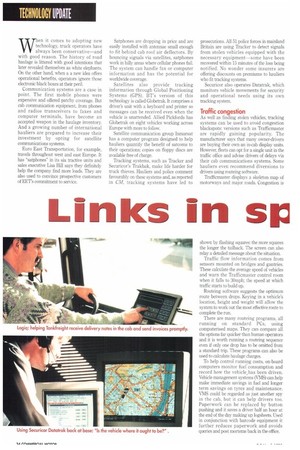Links in sr
Page 36

Page 37

If you've noticed an error in this article please click here to report it so we can fix it.
ice
shown by flashing squares: the more squares the longer the tailback. The screen can also relay a detailed message about the situation.
Traffic flow information comes from sensors mounted on bridges and gantries. These calculate the average speed of vehicles and warn the Trafficmaster control room when it falls to 30mph; the speed at which traffic starts to build up.
Routeing software suggests the optimum route between drops. Keying in a vehicle's location, height and weight will allow the system to work out the most effective route to complete the run.
There are many routeing programs, all running on standard PCs, using computerised maps. They can compare all the options far quicker than human operators and it is worth running a routeing sequence even if only one drop has to be omitted from a standard trip. These programs can also be used to calculate haulage charges.
To help control running costs, on-board computers monitor fuel consumption and record how the vehicle, has been driven. Vehicle management systems (VMS) can help make immediate savings in fuel and longer term savings on tyres and maintenance. VMS could be regarded as just another spy in the cab, but it can help drivers too. Paperwork can be replaced by button pushing and it saves a driver half an hour at the end of the day making up logsheets. Used in conjunction with barcode equipment it further reduces paperwork and avoids queries and post mortems back in the office.
Ian Thomas, general manager of Logiq, stresses that accurate fuel monitoring can only be achieved by using a fuel-line gauge or an electronic probe in the tank: relying on petrol station receipts and calculation of mileages is not enough. He reports that hauliers are invariably surprised by the actual consumption figures when they are properly measured. Installations cost from £1000 but can pay for themselves in less than a year.
Tankfreight assessing a range of new technologies in its fleet of 850 trucks and 1,000 trailers. Initially 60 liquid, powder and gas carrying vehicles have been fitted with Logiq equipment. The satellite link helps the accounts office send out invoices before the end of each month using Logiq's on-line delivery confirmation. Traditionally invoices could not be prepared until each driver returned to base; if this delay ran into the next month end the company had to wait a further 30 days for its money. Tankfreight's David Lodge adds that with in-cab printers, delivery notes can be sent direct to the drivers, so vehicles can stay out longer and this could save companies the cost of running a depot.
Immediate delivery confirmation has helped Tankfreight company win business such as a contract with Castrol to deliver packed lubricants—with more than 1,000 deliveries a day it is essential for Castrol to bill its retailers as soon as possible.
Tankfreight also has PTO sensors to record pump running times. This helps
calculate delivery costs more accurately, especially when the pump may have to run for a couple of hours to empty some loads.
Ray Harding, engineering and technical director of JR Harding & Son in Frome, Somerset, uses Leafield equipment on the company's 50-strong fleet. Electronic logging saves staff costs because drivers can have their computer cards read at unsupervised sites. Job details and time sheets are loaded into the remote PC and the office computer then calls all the outstations to collect the data. Harding says the industry has trimmed its margins so far that there is nowhere else to cut costs and it could be down to the driver to make or break some marginal contracts.
Data collection Leafield's VeMIS on-board data collection and reporting system is also being used by police. forces to supply information about a vehicle's movements immediately before an accident.
The major chassis manufacturers have been quick to see the sales potential of in-cab computer systems—the more money an operator is making, the more likely he is to buy more trucks. Manufacturers have the advantage of viewing new technology (and its applications) from the operators' perspective. This allows them to put together the useful functions in one package rather then operators having to piece together various systems.
In January Volvo unveiled its Dynafleet incab communication and navigation package at the Brussels truck show. It's based on two compatible personal computers which are constantly talking to each other and is aimed mainly at long-haul international operators.
The PC in the cab continuously reports its position to the PC in the traffic office via the GSM international mobile phone network or via geostationary satellites positioned over Europe.
The driver uses his in-cab PC to send back information on, for example, a delay on loading while the traffic office sends him back data on his next drop. This rapid transfer of information on delivery speeds up the invoicing process considerably.
Dynafleet can also transmit data on the vehicle's performance, including fuel consumption, back to the depot and it can supply navigational information, allowing the driver to choose the best route to his next destination.
Dynafleet field trials are being run in Sweden, before its release to a limited number of European
markets "in mid-1995". One of those markets will be the UK.
Although a price has yet to be set, at the Brussels Show a typical installation was being quoted at around £3,200.
L by Eric Russell




























































































